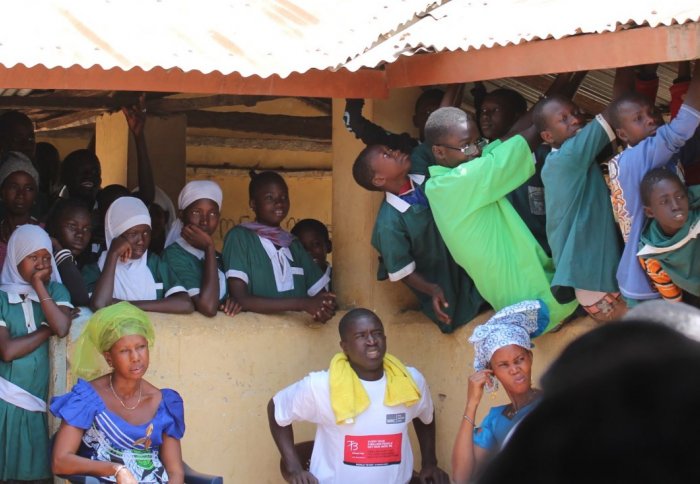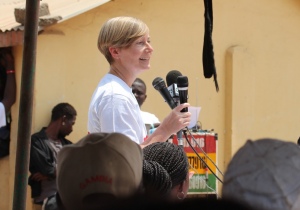
A crowd looks on during a World TB day event in The Gambia. Image credit: Dr Robin Basu Roy.

Doctors, academics, human rights specialists, and policy makers need to better understand each other to effectively help those affected by TB.
Around the world, one million children contract tuberculosis (TB) each year, with around 210,000 dying as a result. As TB is a family disease, even children that do not develop it can suffer; 10 million were orphaned in 2010 by the death of a parent from the disease.
To help children and families affected by TB, doctors, academics, human rights specialists, and policy makers need to better understand each other to work together effectively and bring about real change.
This is the key message laid out in a recent paper produced by researchers from Imperial College London, in collaboration with the Medical Research Council (MRC) Unit The Gambia, and the United Nations International Children’s Fund (UNICEF), published in BMC International Health and Human Rights.
We’re missing opportunities to reduce suffering
– Dr. Robin Basu Roy
Centre for International Child Health
Academics and healthcare practitioners may have the evidence and skills to be able to prevent and treat disease, but often lack insight into the legal and rights-based frameworks that their governments have signed up to. Such human rights frameworks can serve as a means to highlight violations, thereby giving the opportunity to leverage change to improve child wellbeing.
Focusing on the Convention on the Rights of the Child (CRC), the authors argue that a human rights-based approach to improving the lives of children affected by TB should be powerful. The CRC clearly states that children have both an inherent right to life, and to the highest attainable standard of health. As a widely ratified binding legal instrument, it also opens up avenues to hold states to account to ensure that they protect the rights of children affected by TB.
However, as lead author Dr Robin Basu Roy, of Imperial’s Centre for International Child Health, explains, awareness and application of such strategies is not currently widespread.
“If these different professions don’t know how each other’s skills and experience can be utilised through collaboration to help children affected by TB, then everybody will continue to operate in their silos. As long as this is the case, we’re missing opportunities to reduce suffering.
"As health practitioners, we can document and report violations of children’s human rights, and use the CRC to leverage states to deliver funding for interventions that we already know work. This involves contact tracing, preventive therapy, childhood TB training for health workers, and infection control.”
Dr Basu Roy and his colleagues point to the example of Public Interest Litigation recently brought to the Delhi High Court. That case argued that India’s TB policy violated constitutional rights to life and health, leading to the Court ordering that the government meet with the petitioner, with the option of reviving the case if action is not taken.
The CRC emphasizes that states signed up to the agreement must cooperate with each other to contribute to global implementation, in addition to protecting children’s right to health within their own countries.
The authors also argue that as a community, their advocacy strategy needs to be stronger and more inclusive, and also to give voice to children and families directly affected by TB.
Dr. Anne Detjen, Childhood TB Specialist at UNICEF and co-author of the article, said: “Children affected by TB are particularly vulnerable; ‘the neglected of the neglected’, even in the context of child health and survival. They have a right to be heard.”
Lessons can be learned from other disease communities, such as HIV/AIDS, which is far ahead of TB in adopting human rights-based approaches. Those successes give hope for tuberculosis, but rapid and dramatic progress is required to realize the Sustainable Development Goals and WHO End TB strategy, which now aim to end TB and for zero childhood TB deaths by 2030.

Professor Beate Kampmann. Image credit: Dr Robin Basu Roy.
Professor Beate Kampmann, senior author and Director of Imperial College’s Centre for International Child Health said: "It is our responsibility as academics and healthcare professionals and human rights workers to include an advocacy role and operate beyond our normal confines.
"We must now accelerate our efforts to protect the rights of children affected by TB, to reach the most marginalized and excluded, and to change our mindset to use human rights-based approaches to truly leave no child behind.’
"Why the Convention on the Rights of the Child must become a guiding framework for the realization of the rights of children affected by tuberculosis" by Robindra Basu Roy et al. is published in BMC International Health and Human Rights.
Supporters

Article text (excluding photos or graphics) available under an Attribution-NonCommercial-ShareAlike Creative Commons license.
Photos and graphics subject to third party copyright used with permission or © Imperial College London.
Reporter
Mr Al McCartney
Faculty of Medicine Centre

Contact details
Tel: +44 (0)20 7594 2961
Email: a.mccartney@imperial.ac.uk
Show all stories by this author
Leave a comment
Your comment may be published, displaying your name as you provide it, unless you request otherwise. Your contact details will never be published.




Comments
Comments are loading...